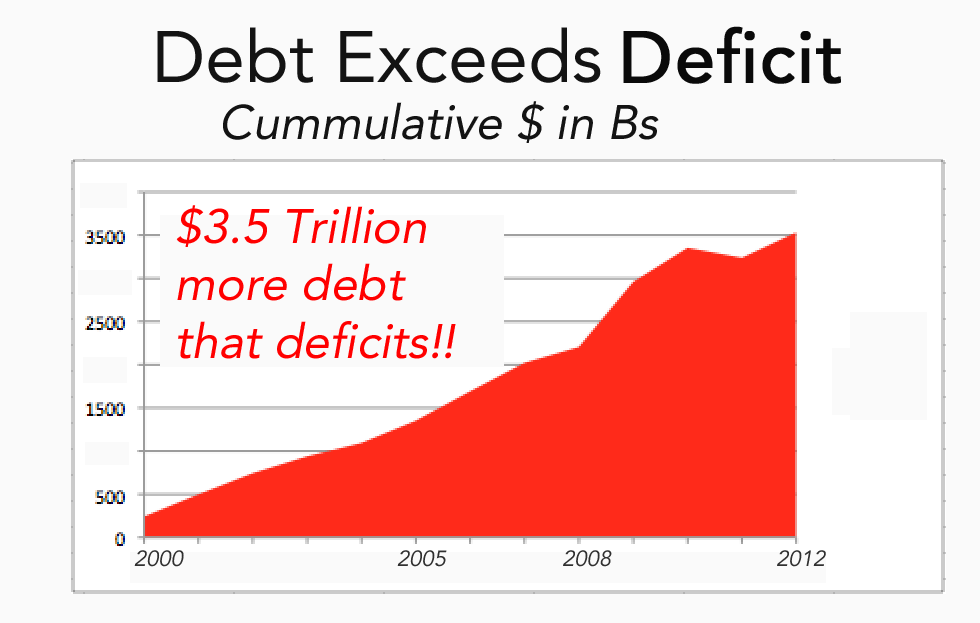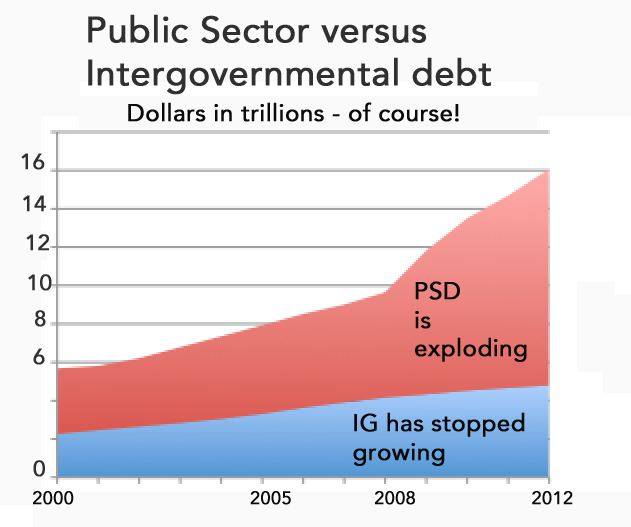There is lots of talk about “deficits” of late. I’m not sure what a deficit really means. Consider the Clinton years - the economy was good, there were no wars or disasters, the deficits were small, there were a few years where there was a budget surplus. – Aaaah. The debt exploded during those “good” years. The cumulative deficit for the Clinton years was only $327Billion, but the debt rose by $1.56 Trillion (475% more debt than deficits).
The deficit is a component of the debt. But it is not the only driver of debt. The following chart is the difference between the reported deficit, and the increase in debt going back to 2000.
The cumulative deficits add up to $6.9T, while the increase in debt is $10.4T. Over the past dozen years, debt has exceeded deficits by $3.5T (50%).
I bring up the discrepancy between debt and deficits to make the point that they are quite different, and any “happy talk” about deficits improving over the next few years should be tempered by the facts about debt.
First an explanation for the $3.5T discrepancy between debt and deficits. The vast majority of the difference is attributable to the country’s Trust Funds (SS, FERS and MRF – private/federal/military retirement). In past years these Funds have had true cash surpluses. The Funds lent the surpluses back to the government, and Uncle Sam promptly spent the loot.
In Washington they have funny accounting system that allows them to create both an Asset (the Funds) and a Liability (Treasury). On a “Unified” basis, the asset and liability net out, and therefore it is magically not reflected in the budget deficit. There are two sets of books, one is flawed accounting, the other is the real debt.
Within the definition of debt is the Debt Owed To the Public (DTP), and the Intergovernmental Debt (IG) (owed to the Trust Funds). Following is a chart of the two categories of debt. Note that DTP has been exploding while the IG debt has stabilized. 
The future of the Trust Funds is absolutely clear. They are in permanent decline. Every year they are forced to redeem a portion of their “savings” to meet current requirements to pay benefits. The cash drain will be approximately $70b in 2013. This will force Treasury to borrow an additional $70B ABOVE and BEYOND what the deficit will be. Every year the TFs will be forced to redeem more and more bonds, and every dollar must result in an increase in the DTP. Over the next few decades the TF will force an increase in the DTP of at least $5T. Five years from now the TFs will be pushing up DTP by $200b a year. After ten-years, the numbers go ballistic.
Again – this increase in DTP will be in addition to the annual deficits the country has now programed in. And again – none of this will ever appear on what is know as the budget.
The budget debate is bullshit - what matters is the Debt to the Public, and no one is looking at that – for now.
- English (UK)
- English (India)
- English (Canada)
- English (Australia)
- English (South Africa)
- English (Philippines)
- English (Nigeria)
- Deutsch
- Español (España)
- Español (México)
- Français
- Italiano
- Nederlands
- Português (Portugal)
- Polski
- Português (Brasil)
- Русский
- Türkçe
- العربية
- Ελληνικά
- Svenska
- Suomi
- עברית
- 日本語
- 한국어
- 简体中文
- 繁體中文
- Bahasa Indonesia
- Bahasa Melayu
- ไทย
- Tiếng Việt
- हिंदी
Deficits Ain’t Debt: In US, Improving Deficits But Rising Debt
Published 01/23/2013, 10:59 PM
Updated 07/09/2023, 06:31 AM
Deficits Ain’t Debt: In US, Improving Deficits But Rising Debt
3rd party Ad. Not an offer or recommendation by Investing.com. See disclosure here or
remove ads
.
Latest comments
Install Our App
Risk Disclosure: Trading in financial instruments and/or cryptocurrencies involves high risks including the risk of losing some, or all, of your investment amount, and may not be suitable for all investors. Prices of cryptocurrencies are extremely volatile and may be affected by external factors such as financial, regulatory or political events. Trading on margin increases the financial risks.
Before deciding to trade in financial instrument or cryptocurrencies you should be fully informed of the risks and costs associated with trading the financial markets, carefully consider your investment objectives, level of experience, and risk appetite, and seek professional advice where needed.
Fusion Media would like to remind you that the data contained in this website is not necessarily real-time nor accurate. The data and prices on the website are not necessarily provided by any market or exchange, but may be provided by market makers, and so prices may not be accurate and may differ from the actual price at any given market, meaning prices are indicative and not appropriate for trading purposes. Fusion Media and any provider of the data contained in this website will not accept liability for any loss or damage as a result of your trading, or your reliance on the information contained within this website.
It is prohibited to use, store, reproduce, display, modify, transmit or distribute the data contained in this website without the explicit prior written permission of Fusion Media and/or the data provider. All intellectual property rights are reserved by the providers and/or the exchange providing the data contained in this website.
Fusion Media may be compensated by the advertisers that appear on the website, based on your interaction with the advertisements or advertisers.
Before deciding to trade in financial instrument or cryptocurrencies you should be fully informed of the risks and costs associated with trading the financial markets, carefully consider your investment objectives, level of experience, and risk appetite, and seek professional advice where needed.
Fusion Media would like to remind you that the data contained in this website is not necessarily real-time nor accurate. The data and prices on the website are not necessarily provided by any market or exchange, but may be provided by market makers, and so prices may not be accurate and may differ from the actual price at any given market, meaning prices are indicative and not appropriate for trading purposes. Fusion Media and any provider of the data contained in this website will not accept liability for any loss or damage as a result of your trading, or your reliance on the information contained within this website.
It is prohibited to use, store, reproduce, display, modify, transmit or distribute the data contained in this website without the explicit prior written permission of Fusion Media and/or the data provider. All intellectual property rights are reserved by the providers and/or the exchange providing the data contained in this website.
Fusion Media may be compensated by the advertisers that appear on the website, based on your interaction with the advertisements or advertisers.
© 2007-2024 - Fusion Media Limited. All Rights Reserved.